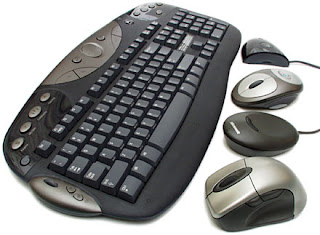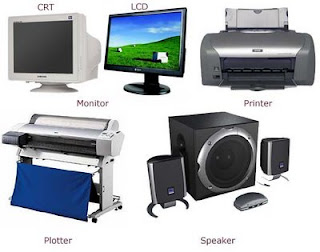Computer Devices
Any machine capable of representing information from a computer. This includes display screens, printers, plotters, and synthesizers.
Input Devices
Any machine that feeds data into a computer. For example, a keyboard is an input device, whereas a display monitor is an output device. Input devices other than the keyboard are sometimes called alternate input devices. Mice, trackballs, and light pens are all alternate input devices.
Any machine capable of representing information from a computer. This includes display screens, printers, plotters, and synthesizers.
Input Devices
Any machine that feeds data into a computer. For example, a keyboard is an input device, whereas a display monitor is an output device. Input devices other than the keyboard are sometimes called alternate input devices. Mice, trackballs, and light pens are all alternate input devices.
Keyboard
A keyboard is the set of typewriter-like keys that enables you to enter data into a computer. Computer keyboards are similar to electric-typewriter keyboards but contain additional keys. The keys on computer keyboards are often classified as follows:
A keyboard is the set of typewriter-like keys that enables you to enter data into a computer. Computer keyboards are similar to electric-typewriter keyboards but contain additional keys. The keys on computer keyboards are often classified as follows:
alphanumeric keys -- letters and numbers
punctuation keys -- comma, period, semicolon, and so on.
special keys -- function keys, control keys, arrow keys, Caps Lock key, and so on.
QWERTY, AZERTY, Dvorak and Other Keyboards
The standard layout of letters, numbers, and punctuation is known as a QWERTY keyboard because the first six keys on the top row of letters spell QWERTY. The QWERTY keyboard was designed in the 1800s for mechanical typewriters and was actually designed to slow typists down to avoid jamming the keys. The AZERTY keyboard is the French version of the standard QWERTY keyboard. AZERTY keyboards differ slightly from the QWERTY keyboard.
Another keyboard design, which has letters positioned for speed typing, is the Dvorak keyboard. Unlike the traditional QWERTY keyboard, the Dvorak keyboard is designed so that the middle row of keys includes the most common letters.
Computer Keyboard Standards
There is no standard computer keyboard, although many manufacturers imitate the keyboards of PCs. There are actually three different PC keyboards: the original PC keyboard, with 84 keys; the AT keyboard, also with 84 keys; and the enhanced keyboard, with 101 keys. The three differ somewhat in the placement of function keys, the Control key, the Return key, and the Shift keys.
In addition to these keys, IBM keyboards contain the following keys: Page Up, Page Down, Home, End, Insert, Pause, Num Lock, Scroll Lock, Break, Caps Lock, Print Screen.
There are several different types of keyboards for the Apple Macintosh. All of them are called ADB keyboards because they connect to the Apple Desktop bus (ADB). The two main varieties of Macintosh keyboards are the standard keyboard and the extended keyboard, which has 15 additional special-function keys.
Mouse
A device that controls the movement of the cursor or pointer on a display screen. A mouse is a small object you can roll along a hard, flat surface. Its name is derived from its shape, which looks a bit like a mouse, its connecting wire that one can imagine to be the mouse's tail, and the fact that one must make it scurry along a surface. As you move the mouse, the pointer on the display screen moves in the same direction. Mice contain at least one button and sometimes as many as three, which have different functions depending on what program is running. Some newer mice also include a scroll wheel for scrolling through long documents.
Invented by Douglas Engelbart of Stanford Research Center in 1963, and pioneered by Xerox in the 1970s, the mouse is one of the great breakthroughs in computer ergonomics because it frees the user to a large extent from using the keyboard. In particular, the mouse is important for graphical user interfaces because you can simply point to options and objects and click a mouse button. Such applications are often called point-and-click programs. The mouse is also useful for graphics programs that allow you to draw pictures by using the mouse like a pen, pencil, or paintbrush.
There are three basic types of mice:
Mechanical: Has a rubber or metal ball on its underside that can roll in all directions. Mechanical sensors within the mouse detect the direction the ball is rolling and move the screen pointer accordingly.
punctuation keys -- comma, period, semicolon, and so on.
special keys -- function keys, control keys, arrow keys, Caps Lock key, and so on.
QWERTY, AZERTY, Dvorak and Other Keyboards
The standard layout of letters, numbers, and punctuation is known as a QWERTY keyboard because the first six keys on the top row of letters spell QWERTY. The QWERTY keyboard was designed in the 1800s for mechanical typewriters and was actually designed to slow typists down to avoid jamming the keys. The AZERTY keyboard is the French version of the standard QWERTY keyboard. AZERTY keyboards differ slightly from the QWERTY keyboard.
Another keyboard design, which has letters positioned for speed typing, is the Dvorak keyboard. Unlike the traditional QWERTY keyboard, the Dvorak keyboard is designed so that the middle row of keys includes the most common letters.
Computer Keyboard Standards
There is no standard computer keyboard, although many manufacturers imitate the keyboards of PCs. There are actually three different PC keyboards: the original PC keyboard, with 84 keys; the AT keyboard, also with 84 keys; and the enhanced keyboard, with 101 keys. The three differ somewhat in the placement of function keys, the Control key, the Return key, and the Shift keys.
In addition to these keys, IBM keyboards contain the following keys: Page Up, Page Down, Home, End, Insert, Pause, Num Lock, Scroll Lock, Break, Caps Lock, Print Screen.
There are several different types of keyboards for the Apple Macintosh. All of them are called ADB keyboards because they connect to the Apple Desktop bus (ADB). The two main varieties of Macintosh keyboards are the standard keyboard and the extended keyboard, which has 15 additional special-function keys.
Mouse
A device that controls the movement of the cursor or pointer on a display screen. A mouse is a small object you can roll along a hard, flat surface. Its name is derived from its shape, which looks a bit like a mouse, its connecting wire that one can imagine to be the mouse's tail, and the fact that one must make it scurry along a surface. As you move the mouse, the pointer on the display screen moves in the same direction. Mice contain at least one button and sometimes as many as three, which have different functions depending on what program is running. Some newer mice also include a scroll wheel for scrolling through long documents.
Invented by Douglas Engelbart of Stanford Research Center in 1963, and pioneered by Xerox in the 1970s, the mouse is one of the great breakthroughs in computer ergonomics because it frees the user to a large extent from using the keyboard. In particular, the mouse is important for graphical user interfaces because you can simply point to options and objects and click a mouse button. Such applications are often called point-and-click programs. The mouse is also useful for graphics programs that allow you to draw pictures by using the mouse like a pen, pencil, or paintbrush.
There are three basic types of mice:
Mechanical: Has a rubber or metal ball on its underside that can roll in all directions. Mechanical sensors within the mouse detect the direction the ball is rolling and move the screen pointer accordingly.
 |
| Input Devices - Keyboard |
Optomechanical: Same as a mechanical mouse, but uses optical sensors to detect motion of the ball.
optical: Uses a laser to detect the mouse's movement. You must move the mouse along a special mat with a grid so that the optical mechanism has a frame of reference. Optical mice have no mechanical moving parts. They respond more quickly and precisely than mechanical and optomechanical mice, but they are also more expensive.
Mice connect to PCs in one of several ways:
Serial mice connect directly to an RS-232C serial port or a PS/2 port. This is the simplest type of connection.
PS/2 mice connect to a PS/2 port.
USB mice.
Cordless mice aren't physically connected at all. Instead they rely on infrared or radio waves to communicate with the computer. Cordless mice are more expensive than both serial and bus mice, but they do eliminate the cord, which can sometimes get in the way.
Trackball Mouse
A pointing device. Essentially, a trackball is a mouse lying on its back. To move the pointer, you rotate the ball with your thumb, your fingers, or the palm of your hand. There are usually one to three buttons next to the ball, which you use just like mouse buttons.
The advantage of trackballs over mice is that the trackball is stationary so it does not require much space to use it. In addition, you can place a trackball on any type of surface, including your lap. For both these reasons, trackballs are popular pointing devices for portable computers.
Lightpen
An input device that utilizes a light-sensitive detector to select objects on a display screen. A light pen is similar to a mouse, except that with a light pen you can move the pointer and select objects on the display screen by directly pointing to the objects with the pen.
optical: Uses a laser to detect the mouse's movement. You must move the mouse along a special mat with a grid so that the optical mechanism has a frame of reference. Optical mice have no mechanical moving parts. They respond more quickly and precisely than mechanical and optomechanical mice, but they are also more expensive.
Mice connect to PCs in one of several ways:
Serial mice connect directly to an RS-232C serial port or a PS/2 port. This is the simplest type of connection.
PS/2 mice connect to a PS/2 port.
USB mice.
Cordless mice aren't physically connected at all. Instead they rely on infrared or radio waves to communicate with the computer. Cordless mice are more expensive than both serial and bus mice, but they do eliminate the cord, which can sometimes get in the way.
Trackball Mouse
A pointing device. Essentially, a trackball is a mouse lying on its back. To move the pointer, you rotate the ball with your thumb, your fingers, or the palm of your hand. There are usually one to three buttons next to the ball, which you use just like mouse buttons.
The advantage of trackballs over mice is that the trackball is stationary so it does not require much space to use it. In addition, you can place a trackball on any type of surface, including your lap. For both these reasons, trackballs are popular pointing devices for portable computers.
Lightpen
An input device that utilizes a light-sensitive detector to select objects on a display screen. A light pen is similar to a mouse, except that with a light pen you can move the pointer and select objects on the display screen by directly pointing to the objects with the pen.














